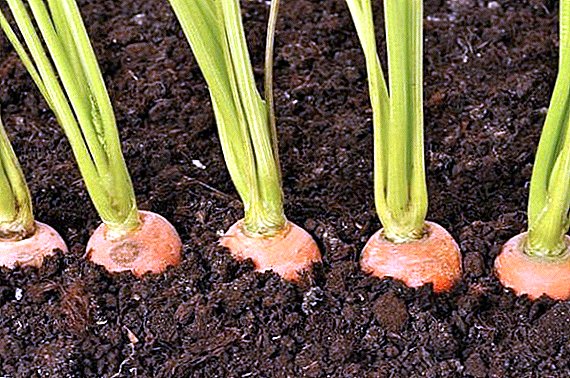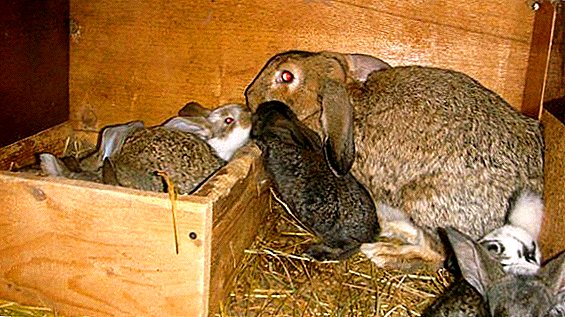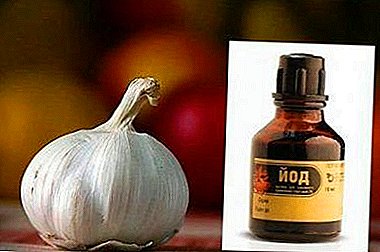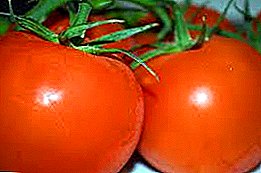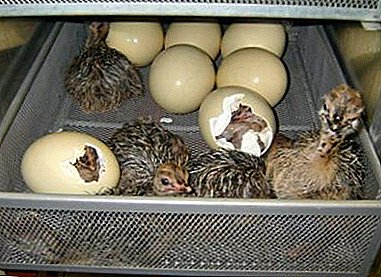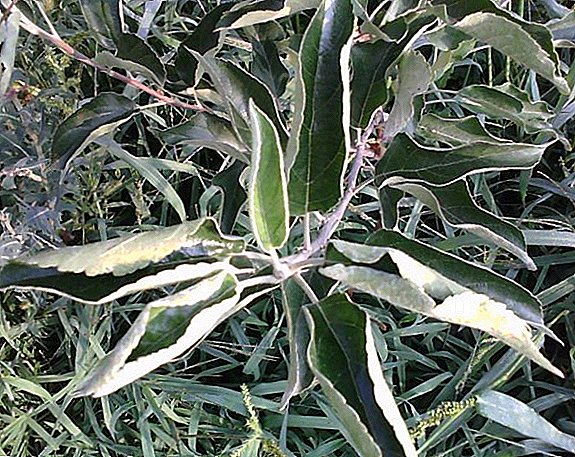 It is difficult to find a person who would not know about the existence of such fruits as apples.
It is difficult to find a person who would not know about the existence of such fruits as apples.
Red, yellow and green fruits are rich in vitamins and microelements, and besides, they can save a lot of diseases.
However, despite the prevalence and simplicity of cultivation, not everyone is able to collect a generous harvest of fragrant fruits, and this is not due to the lack of ovaries in the trees or weather disasters, but various diseases and pests.
Much to our regret, apple trees, like most fruit trees, are subject to various diseases and attacks of pests that can quickly destroy the entire crop and negate all the efforts of the gardener. Timely diagnosis of infection is the key to successful treatment of disease. But in order to properly establish the diagnosis and prescribe treatment, the enemy must be known in person.
Why leaves curl on an apple tree: red-hilly aphid
If you notice that leaves are curling on the apple tree, and do not know what to do, then you must first establish the cause of this unpleasant phenomenon. Young saplings of apple trees are very often attacked by pests, the most common of which is considered to be red-haly aphid. 
Insect can be found on all continents of the globe, with the exception of Antarctica. Krasnogallovaya aphid is considered the most dangerous pest of apple trees. Settling in trees, it not only helps to reduce their yield, but can also become the main cause of the death of the whole plant.
The most common varieties that suffer from red gall aphids are: Antonovka, Cinnamon Striped, Chinese Bellefleur and Rennet Golden Kursk.
When infected by aphids of individual trees in private areas, the use of insecticides is not always advisable, since the probability of destruction of entomophages is high. In this regard, in private gardens it is advised to use traps or glue belts to fight insects.
Therefore, if you notice that the leaves of an apple tree are twisted, then you need to carefully examine the trees for infection.
Did you know? Aphids reproduce through parthenogenesis and live birth. In some species of aphids, newborn females appear already pregnant. It follows from this that the egg inside the mother develops long before the birth of the female herself, and therefore, 10 or 14 days after the birth, she produces new individuals.
 Red-aphid aphid lays eggs in cracks or under loose bark scales on a tree trunk. After wintering during the phenophase, the green cone, the hatched larvae begin to rise en masse to the barely dispersed buds.
Red-aphid aphid lays eggs in cracks or under loose bark scales on a tree trunk. After wintering during the phenophase, the green cone, the hatched larvae begin to rise en masse to the barely dispersed buds.In order to protect the tree and destroy the insect, it is recommended to install glue belts at the height of 1 or 1.5 meters at the end of April - a strip of paper with adhesive on both sides. Sometimes gardeners even use sticky tapes to catch flies, which also gives excellent results and makes it possible to almost completely destroy the livestock of aphids. In addition, adhesive tapes are considered to be an excellent tool for earwigs, cap moths, caterpillars of leafworms, and the apple tree beetle.
Belts are recommended to be changed every 3 or 4 days. And if you consider that the rejection of larvae lasts from 10 to 12 days, then they will have to change three times per season. In order to achieve maximum results from the use of sticky belts, they must fit snugly to the boom, and therefore before installing them it is necessary to thoroughly clean the bark from dead spots, which will help avoid the movement of the larvae under them.
Gardeners make trapping belts from old newspapers or straw and impose them at the end of July on shtamba at a height of about a meter. Females willingly lay their eggs in them, which makes it easy to destroy the egg-laying in limited areas. 
Did you know? Ants are the main defenders of aphids. They contain whole herds of insect pests, as cunning ants love the “milk” that aphids release. To get a drop of tasty mixture, the ant massages the abdomen of the aphid with its antennae. To protect aphids ants build special shelters in which it hides from the weather or the attack of other insects.In case of massive infection, the tree should be treated in early spring, even before the buds are completely insecticidal. For these purposes, gardeners most often use "Nitrafen", "Kemifos" or "Malathion".
From popular methods excellent results are obtained by spraying the trees with soapy water or processing them with an infusion of white mustard powder.
Common Aphid on Apple
The attack of aphids on one tree, if time does not take measures to destroy the pest, can end up for the gardener a whole epidemic.
Parasitic on fruit trees aphid is a small insect. The wings of the female sire are dark brown, the males are bright yellow, and the insect larvae are green and have antennae and red eyes. 
At the end of the summer, females lay many eggs hibernating on the surface of plants. With the onset of heat, the larvae are born and greedily suck out of the tree all its vital juices and useful substances. The transformation of the larvae into an adult takes no more than 14 days: the insect larvae become larger and can reproduce on their own. One individual at a time lays 80 to 100 eggs.
It should be remembered that every second generation gives winged insects that can infect other trees. If you notice that the leaves of the apple tree began to curl, then carefully inspect them for infection by aphids.
If you deploy such a leaflet, then inside you will surely see an aphids. In addition, the affected plants become sticky to the touch, as they are covered with secretion of aphids. Lack of nutrients leads to twisting and deformation of the leaves, and later - to their drying out.
Aphids are not indifferent to young leaves and shoots of trees, and therefore, first of all, the tips of the branches should be examined. If you notice traces of aphids, you should immediately take measures to destroy it.
Insecticides for fighting aphids are used only as a last resort, since all chemicals are unsafe for the people themselves and all other garden residents. And so the fight against the pest should be started by spraying the trees with a mixture of soap and kerosene. The mixture not only allows you to clear the trees of sticky plaque, but also destroys the eggs of pests. In addition, to combat the pest use bitter pepper tincture with soapy water. 
Burning tobacco also gives excellent results. To do this, near the tree make a fire, which is added to the leaves of tobacco. When hot, it gives thick dust, which, rising up, is deposited on all parts of the tree and parasites, which contributes to their maximum destruction.
To get rid of the pest in the summer, during the massive infection of trees, it is recommended to use the Trichlormetaphos solution prepared for 10 liters of water with 20 grams of the product. When using this drug should strictly comply with all safety rules, as its fumes are very toxic and can cause significant harm to human health.
Powdery Mildew Leaves
If you are concerned about the question of why leaves are curled around an apple tree, then carefully examine the plant, as it may be infected with powdery mildew. Virtually all apple diseases are manifested by changes on the leaves, and powdery mildew in this case is no exception to the general rule.
Did you know? Mossy fungi parasitizing on trees prefer to settle on young leaves and branches of the plant, as they contain a large amount of nutrients. To save the conquered territories, mushrooms emit special substances that slow down the aging process in plants. For leaves, such substances are absolutely safe, as they have a short life cycle. It is much more dangerous if the fungus releases these substances into shoots, since in this place not only growth stops, but lignification, as well as the formation of a layer of bark.

The powdery mildew is caused by the powdery mildew. Infection of trees often occurs in early spring. First of all, leaves, buds and young shoots are affected. The appearance of infection contributes to low temperature and high humidity.
The disease is manifested by the appearance on the leaves of powdery off-white or gray. Over time, the bloom acquires a brown color, and a lot of black blotches appear on its surface.
At the initial stage of the disease, plaque is very easily removed, but over time it becomes more dense and begins to separate poorly from the surface of the plant. Infected leaves and shoots begin to curl, turn yellow and dry out. The yield of infected trees is reduced by more than 50%.
If powdery mildew appeared on the apple tree, then it is urgent to begin its treatment. To prevent infection of trees, they should be treated with the fungicidal drug "Topaz". In order to prevent the spread of infection, in the spring and autumn from the tree should try to remove all damaged leaves and shoots. The collected material should be burned. 
To prevent further development of the disease, it is recommended to treat the affected trees after harvesting with a solution of copper sulfate or a 1% solution of Bordeaux liquor.
Treatment of apple from the disease is effective only at the initial stage. If the whole plant is involved in the pathological process, it is better to destroy it as soon as possible, since it will serve as a source of infection in your area.
From shoots and flowers to fruits and leaves: how to cure apple scab
Scab is a fungal infection that affects mainly apples and pears. The disease is spread by spores, and is carried by drops of rainwater. The fungus loves moisture and low temperatures, and therefore a long and rainy spring is ideal conditions for its spread. 
The main symptom of the disease - the appearance of olive-brown on the leaves. Later, the fruit of the plant is also involved in the pathological process, with the result that dark gray cracked spots appear on them. The appearance of cracks in the fruit contributes to secondary infection, which becomes the main cause of their decay.
Due to the fact that the fungus infects leaf stalks, with massive infection, the tree begins to lose leaves intensively. But the infection does not violate the processes of photosynthesis, and therefore the affected tree continues to grow actively. And then the question naturally arises: how to treat a scab on an apple tree?
Important! In private crop production, experts advise to minimize the use of fungicides with a high content of copper, since, even though they are allowed to use, they are very toxic.However, scab is a disease that is easier to prevent than to cure. And therefore, the main task of any gardener is the timely implementation of preventive measures.

To prevent infection of apple trees, you should promptly remove fallen leaves, dried branches and damaged fruit. In the spring, before flowering, the trees should be treated with the Fitosporin-M biofungicide preparation or Bordeaux liquid, and the Fitolavin fungicide can also be used. Spraying of apple trees is carried out both before and after the start of flowering.
Important! When using insecticides and fungicides, be very careful and do not neglect the use of personal protective equipment, as some of them can have a negative impact on the health of even the gardener.However, the question remains what to do if preventive measures have failed, and the signs of the disease have already appeared on the fruit. How to get rid of scab on an apple tree? In cases where the treatment of scab from fungi has proved ineffective, you can try to get rid of the disease with the help of mineral fertilizers.

This method is good because it is both a cure for the disease and plant food. To combat infection, use the following solutions: 15% potassium salt, 15% potassium nitrate, 10% ammonium nitrate, 10% ammonium sulfate. They can also be used for prophylactic purposes, but in much lower concentrations.
Lack of dressings
The fact that the apple tree suffers from a shortage of nutrients, will tell the appearance of the tree.
If the plant lacks nitrogen, its leaves become light green in color, and over time begin to turn yellow and fall off. Lack of nitrogen - the main reason for the decline in the development of apple trees. Trees branch badly, smaller fruits form on them, which eventually fall to maturation.
With a shortage of nitrogen, the stalk of young leaves move away from the shoots at a right angle. Lack of nitrogen - one of the main reasons for the laying of a small amount of fruit buds.
Lack of nitrogen will help to quickly compensate for plant nutrition with ammonium nitrate or slurry. To achieve the fastest possible effect, the plants are sprayed with a 0.5% urea solution. 
If phosphorus is deficient, the leaves of the apple tree become dull, they may appear bronze, as well as a red or purple hue. Dried leaves become almost black. At the same time, the flowering and ripening of fruits begins later than usual, and the leaves fall, on the contrary, too early. In addition, there is a slowdown in the growth of shoots and decreases the hardiness of the tree. Phosphorus starvation is most often observed on acidic soils with low organic content.
With a lack of phosphorus, the apple tree must be fed with superphosphate. If the site is dominated by acidic soils, then fertilizing is carried out with phosphate. Also excellent results are given by the introduction of organic feed in the soil. As a preventive measure, trees are fed with a solution of potassium monophosphate.
Potassium deficiency is manifested by blanching the leaves. They acquire a dull bluish-green color, and their edges curl down, and a drying rim appears on them. In addition, there is an uneven development of the leaf plate, and further wrinkling. Especially pronounced lack of potassium becomes on acidic soils or with the excessive introduction of manganese and calcium.
In this case, the tree loses its winter hardiness and can die even from a slight decrease in temperature. The fruits of the apple become smaller. The introduction of potassium chloride, ash or slurry will help solve the problem. 
If young leaves of an apple tree turn white and curl upward, their growing point dies, and besides this, there is an intense drop of leaves, then this is a sure sign that the plant suffers from a lack of calcium. With a lack of calcium, there is a significant slowdown in the growth of the whole plant.
With calcium deficiency, it is recommended to liming the soil and feeding the apple-tree with calcium sulfate.
Twisting and drying leaves from lack of moisture
Plant tissue is more than 70% water. For the normal formation of leaves, fruits, shoots and roots of a plant consumes a huge amount of moisture. Most of it goes to evaporation through the outer tissues of the apple tree and its foliage. Moisture for plants is the main source of life and normal development. If a tree chronically loses moisture, then over time its leaves begin to curl, dry out and fall off.
The plant receives moisture from the soil, since all useful substances necessary for normal life of the apple tree dissolve in it. In order for an apple tree to grow and develop normally, the moisture content of the soil on which it is cultivated must be at least 65%, but not above 80%. The lack of moisture leads to premature aging of the tree, the absence or dropping of the ovary. This becomes the main cause of irregular fruiting and reduced winter hardiness. 
If you notice that the apple tree suffers from a lack of moisture, immediately correct the watering, as this can lead to the death of the plant. Remember: young plants are watered once a week, and mature trees as needed. If you notice that the soil near the apple is very dry, then do not be lazy and please the plant with several buckets of clean water.
An apple tree is the most grateful garden tree, which always responds with generous yield to care and attention.



